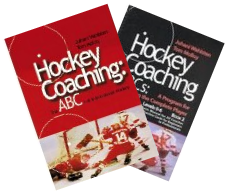Pops I moved this discussion to here.
Pops, this is a pro team. The shifts are never more than ten seconds and the goal on offense is to score by creating confusion or great moves. On defense they must fight thru picks and communicate. So there is not a lot of standing around because it is a specific situation and the shifts are so short and totally anearobic.
With your college team you could have half the team at one end and the other half at the far end doing something else. The team was getting prepared to play a team that puts the puck deep and F1 forechecks on the puck and F2 comes down the weak side for a pass behind or to take away a low D to D pass.
When Perry Pearn, one of the Montreal asst. coaches was at NAIT in Edmonton he had a powerhouse team with a forecheck that did this with F1 and F2. D1 pinched all the way down and F3 filled. I coached against him for 4 years and it was almost impossible to get out of your end when they went to a full press. So if you are going to play against a team that does this kind of thing you have to prepare. The pro coaches in Salzburg sit at their computers for hours every day and use the Steva program that allows you to save and view clips from any part of a game. They identify what they need to work on for the next opponent or a weakness in their play and devise a drill for it.
This drill is just one segment of practice. They use a lot of full ice controlled scrimmage and transition games such as a continuous 3-2 where one supporting player comes in to give low support creating a low 3-3 and the other F and a D are passive waiting to breakout and defend the 3-2 the other way.
Pops Ryan
The most honest comment that I can make right now is this: In my area I am blessed in having a good reputation and equally fortunate in having a decent Wins/Losses record. When I come on this site it feels much like being back in elementary school, where I would just listen to the teacher in amazement and wonder how they knew so much.
There are so many good ideas here and so much information to absorb that one realizes that the art of 'Coaching' is truly a life-long process. Having F-2 come down the weak side is something that never occurred to me. I always had F2 making the read...and like many others was always prone to a good D to D against us. Now that I have given it a few minutes of thought and noodled around with it the concept makes all the sense in the world....if F3~D1 are timely in their coverage. I am adding this concept to this years Playbook and offer sincere thanks. My only question, Tom, is what do you recommend when the other team makes a clean breakout and both F1 and F2 are already behind the puck. It appears that they need to come back pretty hard. I would think that F3, D1 and D2 need to take away the mid ice pronto.
Pops
Pops, I just listened to Bjorn Kindings talk at the conference during the World's in May. He shows how the defense is collapsing with everyone low but also how they are overloading on the strong side and outnumbering the attackers. He also goes thru how the third man in the play such as a breakout is crucial with this defensive overloading.
If F1 and F2 are caught deep then they must come back hard thru the middle, they have to beat the D up the ice. D1-2 and F3 are all above the puck so all you are giving up if they read properly is a 3-3.
In Austria we always had 4 players on the attack and overloading one side on the forecheck with the LD supporting at the right point. The RD went all the way in on the right side alone with the C and RW and the LW hung back. On the left side all three F were in supported by the LD. Last year they went to total hockey with the first 3 in forechecking on the puck side and 4 and 5 back.
The offenses have to catch up with the defensive play to create more scoring chances.
Hockey is one of the only sports that shares ideas from around the world at these international symposiums and now that the IIHF has put the presentations online it is easy for all coaches to access them. I don't know if they have implemented the lower individual price yet.




This is probably stating the obvious, but I like to go 2 v 2 to 3 v 2 to 3 v 3. In the 3 v 2 the O has to set up from behind the net. In the 3 v 3 we use 1 D-Man with 2 Wingers per side as much as possible. It seems more 'game like' than having 3 wings versus 3 other wingers. As with most teams in the eastern US we only get the ice twice a week for 90 minute sessions. Practices need to be drafted in advance; down time is the enemy when you are limited to 3 hours a week. How often do you guys do the 2 v 2 & 3 v 3 drills? What percentage of your practice time do these particular sessions consume? I'm 'old school' and, to be honest, enjoy the 5 v 5 scrimmages more than anything.